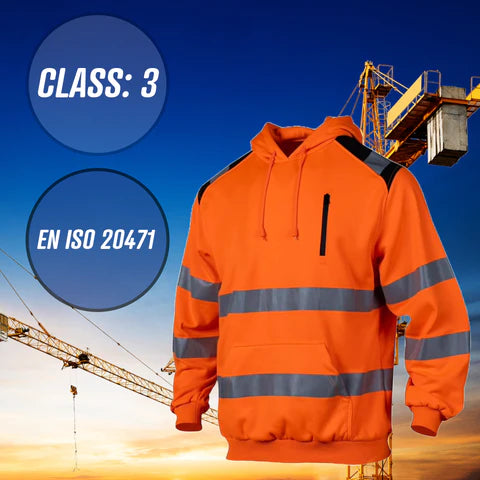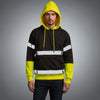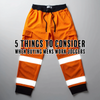What Make Hi Vis Hoodies Conform to EN ISO 20471
- Posted by Olivia M

High-visibility clothing, also known as "hi-vis clothing" is designed to make the wearer more visible, especially in low-light conditions or environments with moving vehicles. These clothes are often categorized into different classes based on their visibility features and intended use. Here are the typical classes:
-
Class 1: This class offers the lowest level of visibility enhancement. It's suitable for environments with minimal risks, such as off-road work areas or parking lots. Class 1 garments usually have a small amount of high-visibility material, like reflective tape, and are typically worn by workers who are not exposed to traffic.
-
Class 2: Class 2 garments provide better visibility compared to Class 1. They are typically worn in environments with moderate risks, such as construction sites or roadways where traffic speeds are relatively low. Class 2 clothing features more high-visibility material and may include fluorescent background materials with retroreflective bands around the torso and sleeves, items such as sleeveless vests and basic hi vis hoodies come in this class.
-
Class 3: This class offers the highest level of visibility. Class 3 garments which can be orange hi vis hoodies are designed for environments with high-risk factors, such as highway construction zones or areas with fast-moving traffic. They typically feature the most extensive coverage of high-visibility material, including fluorescent background materials with retroreflective bands on the torso and sleeves, as well as across the shoulders, so a well designed hi vis hoodie can meet this class if it includes vertical strips on the shoulder area and horizontal bands across the torso and sleeves.
-
ANSI/ISEA 107 and EN ISO 20471: These are standards developed by the American National Standards Institute (ANSI) and the European Committee for Standardization (CEN), respectively, to regulate the design and performance of high-visibility clothing. These standards specify requirements for fluorescent background materials, retroreflective materials, garment design, and visibility performance. Garments compliant with these standards are usually designated by their class and certification level.
When selecting high-visibility hoodies, it's essential to consider the specific requirements of the work environment and any applicable safety regulations or standards. Additionally, proper maintenance, such as keeping the garments clean and replacing them if they become damaged or faded, is crucial to ensure ongoing visibility and safety.
Performance criteria for highly visible hoodies, as outlined in EN ISO 20471, includes the design and functionality specifications for each garment component. Typically, these modules encompass three primary elements:
First and foremost, latest standard is called EN ISO 20471:2013 & A1:2016, lets look at what's need to make a hi vis hoodie conform to this standard.
-
The Main Material: The fabric is has to be fluorescent, with 3 popular colours, Lime-Yellow, Orange and Red. This module is the basis of amplifying visibility during daylight hours and can augment visibility in low-light conditions.
-
Reflective Strips/Bands: Engineered to heighten visibility during darker periods, retroreflective strips necessitate a light source to activate retroreflection. They are indispensable for individuals working at night and will prove to be an important part in your safety.
-
Contrast Material: Certain high visibility garments incorporate darker-hued sections that are less prone to accumulating dirt compared to fluorescent material and reflective strips. These areas, typically covered with contrast fabric, are strategically placed where dirt accumulation is most probable, such as sleeve ends and lower mid region. These sections are crucial for maintaining functionality, as dirt accumulation could compromise visibility. The hi vis hoodie can have panels and cuffs in two-tone contrast.
Hi Vis Hoodies should be labelled with the EN ISO 20471 icon and accompanied by the relevant class number.

Can a Hi Vis Hoodie be Class 3 ?
Yes, for a Hi Vis Hoodie to conform to High Visibility Class 3, which is the highest level of visibility, the hoodie must be fully sleeved and also cover the torso area, which includes the core of the body. It must have reflective bands on the shoulder in addition to the standard class 2 requirements.
The image below shows the visual requirements of a hi vis hoodie that meets class 3.





















